The Shift in Digital Learning Modalities: Is Higher Education Ready?
Published by: WCET | 3/30/2023
Published by: WCET | 3/30/2023
As we travel further into this post-pandemic era, I am struck by a recurring theme. The mix of courses with digital components demanded by students and offered by institutions has changed. And this shift is having real impact on campuses.
In this post, I will reflect on that theme plus highlight a new WCET publication. This new report, released today, details the results of a survey on faculty and student desires regarding digital learning offerings and faculty readiness for the digital learning shift.
And, not to give away the ending right at the beginning of the post, but some big questions still loom:
Whether hearing from people in states that are big, small, east, or west, I have been in meetings over the last year where the conversations are eerily similar. For many institutions, enrollment patterns in online, hybrid, and in-person courses are not what they were pre-pandemic. The online and hybrid registrations remain higher than in pre-pandemic days. This has had some real impacts. Some senior faculty are not able to fill their course loads during in-person traditional timeframes. Some faculty and staff now live in other states. Buildings feel a bit emptier. Legislators are noticing. An accrediting team questioned an institution as to why faculty development was not keeping up with increases in digital courses. And how do we pivot student services to meet student needs where (and when) they are now?
The numbers support the idea of a shift. Phil Hill, of Phil Hill & Associates (formerly MindWires) and the publisher of the On EdTech blog, analyzed the U.S. Department of Education’s Fall Enrollment survey statistics. The graph below (used with permission) tracks the trends of fall enrollments of students taking at least one online course.
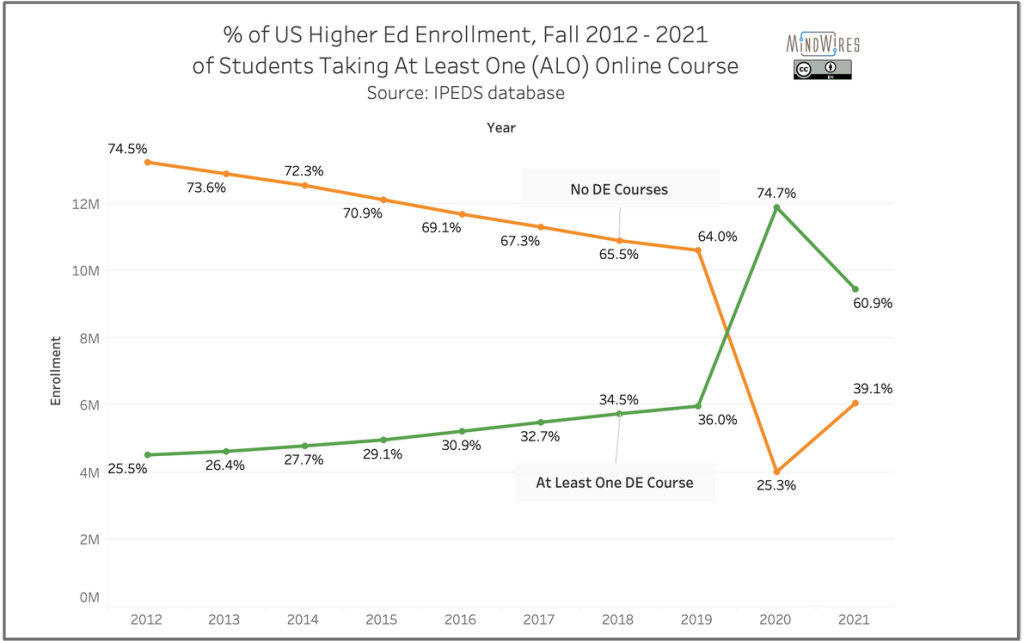
The COVID-plagued year of 2020 was an anomaly as institutions pivoted to “emergency remote learning.” It seems apparent that many institutions reported these courses as “distance learning,” even though IPEDS instructed them not to do so. Admittedly, we might see some of that same misreporting in 2021, but colleges and universities were starting to, and please excuse me for using this phrase, “get back to normal.”
The statistical data backs the non-scientifically collected anecdotes that were forming a pattern in my mind.
It turns out that we asked these questions last year in WCET’s national survey of faculty and administrators regarding their agreement with definitions of digital learning terms (i.e. online, hybrid, hyflex, and in-person). In that survey, we were somewhat surprised with the overwhelming level of agreement on all the terms except for hyflex, which was the newest concept.
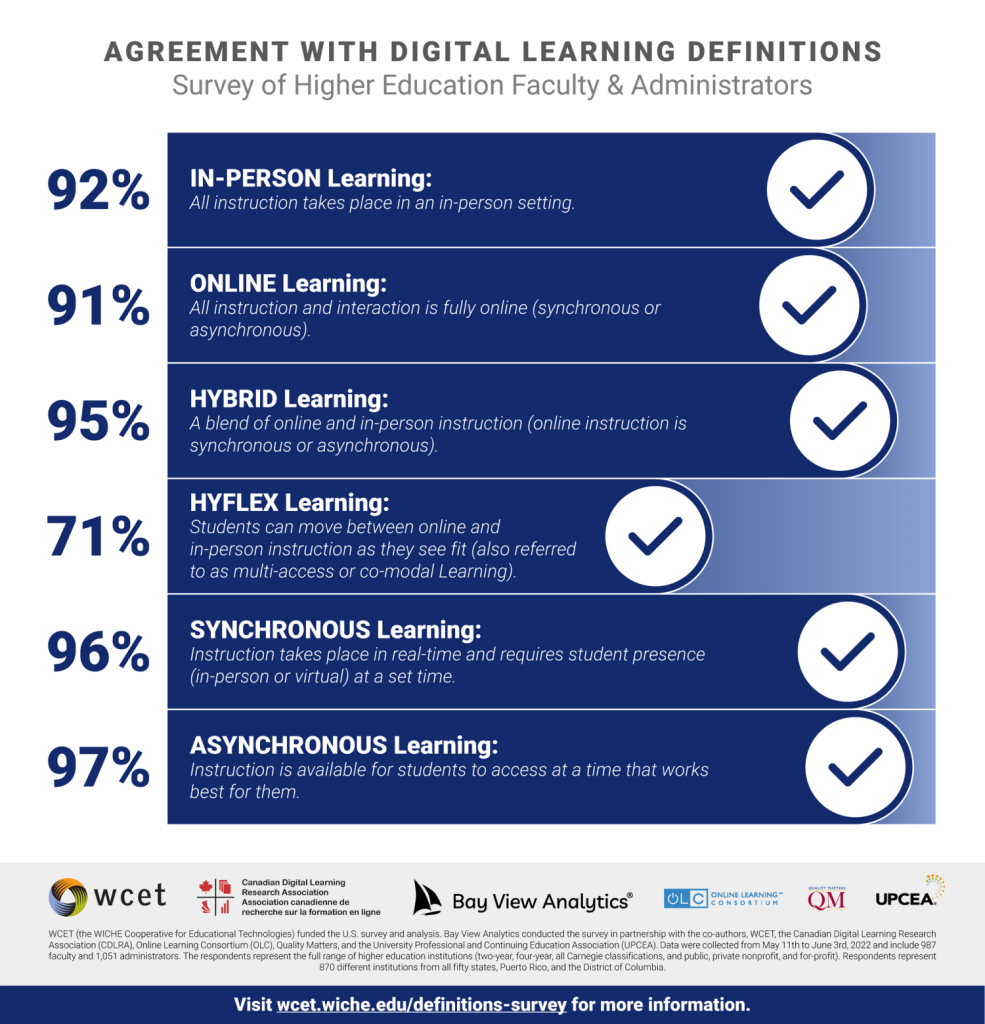
As we release our second report based on the survey, we wanted to highlight some of the additional results.
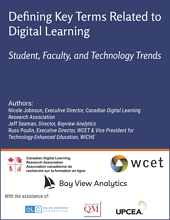
But first, WCET staff thank Jeff Seaman, Bay View Analytics, for conducting the survey, and Nicole Johnson for performing the analysis. The questions were based upon definitions Johnson developed for her organization, the Canadian Digital Learning Research Association (CDLRA). Along with CDLRA, we are grateful to the Online Learning Consortium (OLC), Quality Matters, and the University Professional and Continuing Education Association (UPCEA) for their assistance in soliciting respondents and disseminating the results.
Participants in this study consisted of 987 higher education faculty and 1,051 administrators representing 870 institutions from all fifty states, Puerto Rico, and the District of Columbia.
The second report (released today) focuses on survey results regarding technology trends and asked some key questions about shifting perceptions and planned uses of academic technologies.
The results add more insights into faculty and staff desires regarding learning modalities.
Yes, they do. Admittedly, this is not a direct survey of students’ wants and needs, but the perceptions of faculty and administrators. It is notable that they are largely in lock step with those perceptions. More than three-quarters of all responding groups either strongly or somewhat agreed that students now seek more flexibility in how they access their courses. More than half of the non-faculty groups strongly agreed.

Most participants agreed that faculty want more flexibility in how they deliver their courses, although the agreement was not as pronounced as for students. It is important to note that senior administrators and faculty, themselves, were most likely to report agreement about the desire for flexibility. More than 40% of faculty strongly agreed with this statement.
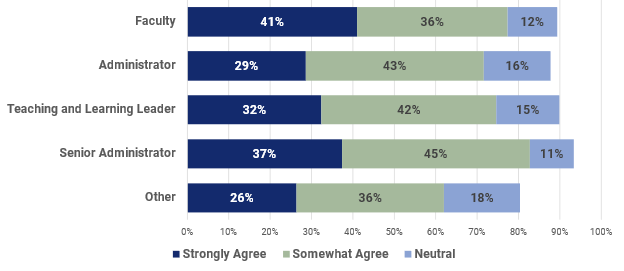
Along with the anecdotes and student enrollment numbers, this survey showed both faculty and (perceived) student interest in having options beyond the traditional in-person, lecture modality.
Another question that we asked in the survey probed the readiness of faculty for teaching in different modalities. The results of questions around faculty readiness and related questions around specific technologies they use in each modality are included in the new report released today.
The percentage of respondents who strongly agreed with this statement was very low. The combination of strongly and somewhat agree was below half for all categories and differed by group.
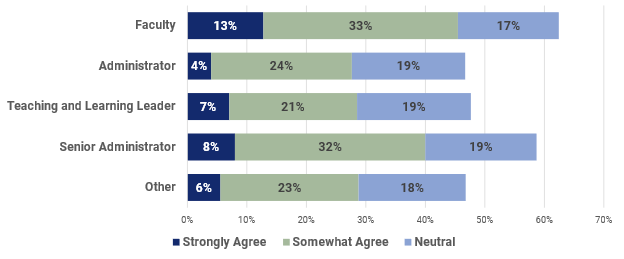
From the report:
“Despite the increased use of digital resources and technology along with the desire for increased flexibility, most participants did not agree that faculty had the skills and know-how to effectively deliver courses in multiple modes. Faculty were more likely to perceive themselves as having the necessary skills and know-how than participants in other roles.”
As for the faculty not being ready, we should not flog ourselves over this result. The shift has been sudden. We are still in a bit of shock and recovery mode from the pandemic. It will be a difficult task to assure that the skills necessary to keep up with the perceived desires for both faculty and students. And this new set of skills is not solely on the shoulders of faculty, but also needs to be part of the thinking of administrators at all levels and policy-makers both inside and outside of higher education.
Maybe this discussion is happening on campus, but I have been surprised that this issue has been relatively absent among higher education organizations, policymakers, the press, and the public, at large.
Maybe I missed it somewhere? If it is not being discussed, I am at a loss as to why. This shift is changing college and university operations and economics…in a dramatic way for some institutions.
We hope that the results from the survey report released today help fuel the discussion.
I understand that it takes time to regain our equilibrium from a sudden shift. To move forward in a world where the demand for course modalities has changed, we need to gather ourselves, collect the data, organize our thinking, and talk about it so that we can map our new direction.
Executive Director, WCET & Vice President for Technology-Enhanced Education, WICHE (retired)